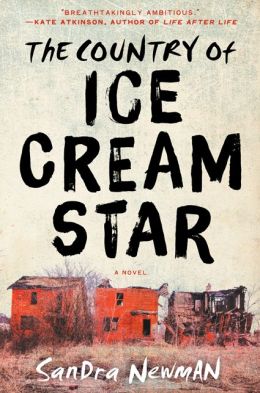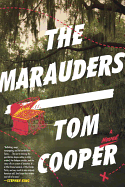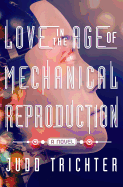 |
| photo: George Baier |
Sandra Newman has taught writing and literature at Temple University, Chapman University and the University of Colorado. Her work has appeared in Harper's, Granta and London's Observer. Her debut novel, The Only Good Thing Anyone Has Ever Done, was shortlisted for the Guardian First Book Award. Her third novel is The Country of Ice Cream Star, 600 pages of linguistically creative prose told from the viewpoint of a 15-year-old orphan searching for safety and redemption in a politically fractured, dystopian America (reviewed below).
How did you create this dystopia?
It started with the simple idea of a future in which everyone died before they reached adulthood. Everyone is born with a disease which kills them when they're 18 to 19 years old. When I started trying to write the book, I immediately encountered a major problem. I started out writing it in Standard English in the first person from the point of view of my heroine, Ice Cream Star, trying only to imagine the voice of a 15-year-old. Since the book is set 100 years in the future, it struck me as unrealistic that she would use contemporary English. I couldn't make anything about it feel real. I decided, with some trepidation, to invent a future patois for the world I was creating, finding the inspiration for it in African-American English--[the source of] a lot of contemporary slang that would be comprehensible to most people. Once I had the basic ideas for the origins of the patois, it came very quickly; I wrote the first page in a half hour. I was thinking more seriously about the racial make-up of my future people. I'd assumed that they would be a typical American mix, but it now occurred to me that they could all be black. And this idea was immediately powerful to me. The whole society came to life, as if it had always existed and I was just stumbling upon it. Then it seemed obvious to me that Ice Cream's quest would be triggered by the appearance of an adult--a white adult--the sort of person Ice Cream has never seen before. Now she knows it's possible there's a cure for the disease everyone is dying from, and she has the rationale for her quest. Meanwhile, the reader knows from a thousand years of history that the sudden appearance of a white person is bad news.
Your novel has been compared with Russell Hoban's Riddley Walker. Is this a fair assessment?
It's certainly a flattering assessment, though it's probably an inevitable one, since both books have a post-apocalyptic setting plus an invented dialect. Ultimately, the mood and structure of my book is very different. Riddley Walker is much more dystopian. In Ice Cream Star's world, everyone is doing pretty well in a relatively carefree world, even Edenic, until the white people appear. When they depart from that world, it turns into an adventure story rather than a voyage to the heart of darkness, full of people outwitting each other or engaging in trench warfare or having sex. It certainly has its thoughtful elements, but it's not nearly as meditative as Riddley Walker.
 What other works and authors influenced you?
What other works and authors influenced you?
Riddley Walker and A Clockwork Orange are somewhere in the mix, because when I came to write Ice Cream Star, I already had the idea that a book in an invented dialect was possible. At the time I began The Country of Ice Cream Star, I was finishing a book on Western literature, and for the purposes of writing, I had to read, re-read or at least re-skim the entire Western canon. Generally, I find I often try to be influenced by books, but it doesn't have any effect that I can see. When I was writing Ice Cream Star, I read both Shakespeare and [Toni Morrison's] Song of Solomon with this in mind--I was thinking, this is what you should be influenced by.
The Sengles speak a kind of creole language, which you're able to carry through 600-plus pages in poetic, lyrical prose so it becomes second nature to the reader. Were there other languages besides Afro-American English that inspired you?
As I've mentioned, the main inspiration for the language was African-American English. There's also a peppering of French words--the Sengles are descended from Senegalese immigrants, so they have French in their background. Retrospectively, I can also see that some of the logic of it comes from Russian, though I wasn't conscious of this at the time.
Tell us how you created this "second" language.
If I'd had to build it consciously, I probably would have given up. I can't really explain this, except to say that it's very similar to the experience of writing a character whose voice just "comes" to you, even though you've never known anyone quite like that. You know the character is somehow cobbled together from people you've known, but very little of the process is conscious. My main concerns were that it should be beautiful, that it should feel real, and that it shouldn't be too hard to understand. In this way, it was a lot like any other writing. I'd constantly have to be inventing new words and idioms, which could be time-consuming, but the basic nature of the task was the same.
Do you have training in anthropology or linguistics?
I have a layman's interest in anthropology, and I love to read about other cultures. But I also have to admit, some of my study of other cultures comes from reading science fiction; in my mind, the boundary between reading about Amazonian cultures and Aldebaran cultures is not that sharp. It's all about the different configurations that human societies could fall into, and to me, a plausible fiction is just as interesting as an implausible fact. As far as linguistics goes, I did a BA in Russian, and since then, I've studied a lot of languages to some degree. Since I'm not using these languages for anything practical, I never learn them very well. I'm mainly fascinated by exotic grammatical structures, so once I've learned the peculiarities of the grammar and syntax, I tend to abandon the language altogether.
In the book, there is a subtext of cultism, particularly concerning the Catholics in the guise of the Marias, and also of ethnic division and subjugation. How much of the current racial and religious climate played into creating this world?
The treatment of religion and racism in the book obviously has overtones from the current racial and religious climate. These kinds of echoes are inevitable, and they're part of the pleasure of writing such a book. Specifically, the Mariano religion is clearly a bit of a parody of Catholicism, and of the Christ story in general. I was inventing beliefs which serve the purposes of the societies they exist in... to function like real religions. In the political realm, the devout often use their religion as an excuse for doing what they want to do, where religion is a way of gaining and cementing power, although that doesn't mean people are being consciously cynical. The book is mainly about power, and religion is just one of the ways people exercise power over each other.
In the America of the book, everyone is black, so there are no "race relations." When white people do appear, there's no context for it. Even in Marias city, where there's a mythical belief in the perniciousness of whites which obviously derives from the past, when Marianos are confronted with a real-life white man, he's weird and exotic. There's distaste or amazement at the white man's bizarre appearance, and a suspicion that he might not really be human. But the real hostility only comes when it turns out the white people are not just funny-looking, but up to no good.
What's next on the project horizon?
My next project is a sequel to The Country of Ice Cream Star, which begins exactly where the first book leaves off. She still hasn't conquered the world yet, so she needed another book. --Nancy Powell, freelance writer and technical consultant
Sandra Newman: Creating the Dialect of Dystopia
 Rutherford B., Who Was He? by Marilyn Singer, illustrated by John Hendrix, uses one poem to introduce each president, offering key facts and varying the mood to reflect the times (Rutherford B. Hayes, incidentally, signed into law a remembrance of Washington's birthday, the first incarnation of Presidents' Day, which now honors both Washington and Lincoln). In Kid Presidents: True Tales of Childhood from America's Presidents by David Stabler, illustrated by Doogie Horner, the author organizes stories about the presidents' youth into sections such as "After-School Activities"--tales of them as pranksters--and "Hardly Working," about the various jobs taken by would-be presidents to earn spending money.
Rutherford B., Who Was He? by Marilyn Singer, illustrated by John Hendrix, uses one poem to introduce each president, offering key facts and varying the mood to reflect the times (Rutherford B. Hayes, incidentally, signed into law a remembrance of Washington's birthday, the first incarnation of Presidents' Day, which now honors both Washington and Lincoln). In Kid Presidents: True Tales of Childhood from America's Presidents by David Stabler, illustrated by Doogie Horner, the author organizes stories about the presidents' youth into sections such as "After-School Activities"--tales of them as pranksters--and "Hardly Working," about the various jobs taken by would-be presidents to earn spending money.



 What other works and authors influenced you?
What other works and authors influenced you?










